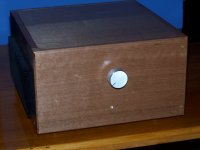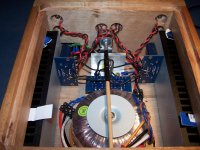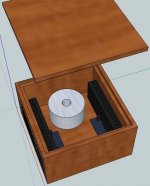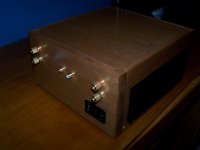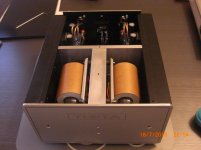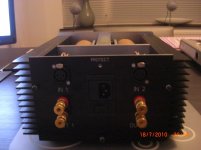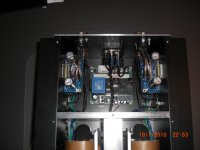Hi Peter, Brainiacs
I have a problem. I'm sorry to ask, but if anybody can help me, it's surely you kind fellows.
My Audiosector Gainclone LM3875 has stared to oscillate recently, meaning that there is a throbbing noise through my speakers (at roughly 3x throbs per second) of earth-hum type noise. Do you have any idea what could have caused this? It's all wired up properly and this has happened fairly recently, to both channels. Could it be changes I have made to my speakers? I have tried another, unmodified set, and the issue is still there. A point of note is that the throbbing vanishes if I place my hand near but not touching the caps/chip area, OR actually touching the caps (which incidentally are naked metal since somebody recommended this - I foolhardily peeled them, but of course this is a case of the emperor's clothes - not a real world improvement in sound. They are, of course, not touching anything but their pin holes) So, I guess something is transmitting and receiving current of some kind, that my body is kindly earthing, if I stand around with my hand nearby.
Any ideas?
Many thanks for your time and brainpower
Lucas
I have a problem. I'm sorry to ask, but if anybody can help me, it's surely you kind fellows.
My Audiosector Gainclone LM3875 has stared to oscillate recently, meaning that there is a throbbing noise through my speakers (at roughly 3x throbs per second) of earth-hum type noise. Do you have any idea what could have caused this? It's all wired up properly and this has happened fairly recently, to both channels. Could it be changes I have made to my speakers? I have tried another, unmodified set, and the issue is still there. A point of note is that the throbbing vanishes if I place my hand near but not touching the caps/chip area, OR actually touching the caps (which incidentally are naked metal since somebody recommended this - I foolhardily peeled them, but of course this is a case of the emperor's clothes - not a real world improvement in sound. They are, of course, not touching anything but their pin holes) So, I guess something is transmitting and receiving current of some kind, that my body is kindly earthing, if I stand around with my hand nearby.
Any ideas?
Many thanks for your time and brainpower
Lucas
When you want it to sound even better the boutique components will make a difference. After the input caps your best improvement in my opinion is an obscene power supply. I like the one from chipamp.com that is meant for the miniA amplifier. 9 dollars for the board and then probably 40 more to populate it. Use a decent 160VA transformer up to about 300VA. Toroid transformers are preferred and are cheap from Antek, Inc. He is super reasonable on shipping as he uses flat rate USPS and will put as many as fit in one box for only one shipping charge.
Uriah
PS so where's the pics!
Cheers for the advice.
Here are the pics, feel free to criticise. I'd love to hear what I've done wrong or what I can improve upon.
I'll just point out from now that these pics were taken before the amp was 100% completed, the heatsinks are now grounded. I still need to secure them properly also. The volume shaft is also temporary, matter of fact, the whole case is temporary as I have made it far too small for my liking. I will have to last until my summer break. When I was designing my case using Google SketchUp, I didn't realise how cramped the case was going to be after wiring up the amp. I still managed in the end.
Attachments
I see nothing wrong with the way you have used the space available to you.
It works and you have room to check and/or maintain the innards.
One Safety question.
Are all the exposed conductive parts connected to Safety Earth?
No metal chassis makes this more difficult in that separate grounding wires must be run to every exposed conductive component. I think I count 9.
It works and you have room to check and/or maintain the innards.
One Safety question.
Are all the exposed conductive parts connected to Safety Earth?
No metal chassis makes this more difficult in that separate grounding wires must be run to every exposed conductive component. I think I count 9.
Last edited:
Hi Andrew, good to know that it generally looks ok.
I would say yes, anything that is conductive that is accessible from the outside of the case is grounded to the safety earth (including the heatsinks as the picture does not show). I read many informative posts (many of them yours, haha) about grounding safely and not including items such as 10R resistors in the audio ground path.
I would say yes, anything that is conductive that is accessible from the outside of the case is grounded to the safety earth (including the heatsinks as the picture does not show). I read many informative posts (many of them yours, haha) about grounding safely and not including items such as 10R resistors in the audio ground path.
Is the Gainclone in a grounded chassis?
It's in a wooden chassis. There's no metal in there but the sinks and the circuit. The heatsinks are earthed with wires, but it makes no difference to the noise if they're earthed or not.
Should the metal exposed caps be earthed???? Sounds hazardous.
I am feeling the caps are what's pumping noise out, and certainly if I touch them, the throbbing noise is reduced to almost nothing (95% reduced), but as I said, even approaching the amp circuit area reduces noise mostly. The CG is connected directly to the earth pin at the socket connector, as is the heatsink, but that's all.
Thanks
It's in a wooden chassis. There's no metal in there but the sinks and the circuit. The heatsinks are earthed with wires, but it makes no difference to the noise if they're earthed or not.
Should the metal exposed caps be earthed???? Sounds hazardous.
I am feeling the caps are what's pumping noise out, and certainly if I touch them, the throbbing noise is reduced to almost nothing (95% reduced), but as I said, even approaching the amp circuit area reduces noise mostly. The CG is connected directly to the earth pin at the socket connector, as is the heatsink, but that's all.
You may try adding small cap as described here: http://www.diyaudio.com/forums/audi...-kit-building-instructions-3.html#post1516522
If that won't help, try adding Zobel (Rz 2.7R and Cz 0.1uF on amp board).
If noting helps, you may be forced to add some shielding to amp circuit.
I have some amp running without any enclosure and in my listening environment it's not a problem, but with other setups it may be different.
My first gainclone
One build. Another to go.
http://www.diyaudio.com/forums/attachment.php?attachmentid=180791&stc=1&d=1279486621
http://www.diyaudio.com/forums/attachment.php?attachmentid=180793&stc=1&d=1279486621
http://www.diyaudio.com/forums/attachment.php?attachmentid=180794&stc=1&d=1279486621
One build. Another to go.
http://www.diyaudio.com/forums/attachment.php?attachmentid=180791&stc=1&d=1279486621
http://www.diyaudio.com/forums/attachment.php?attachmentid=180793&stc=1&d=1279486621
http://www.diyaudio.com/forums/attachment.php?attachmentid=180794&stc=1&d=1279486621
Attachments
You may try adding small cap as described here: http://www.diyaudio.com/forums/audi...-kit-building-instructions-3.html#post1516522
If that won't help, try adding Zobel (Rz 2.7R and Cz 0.1uF on amp board).
If noting helps, you may be forced to add some shielding to amp circuit.
I have some amp running without any enclosure and in my listening environment it's not a problem, but with other setups it may be different.
Peter, thankyou for your advice. I have done some experiements regarding positioning in relation to other electronics, and it is indeed an issue of EMI, not supply contamination, although one socket in the room eliminates the problem when there are no other electronic nearby. Interestingly, even with other electronics nearby, unplugged from the mains, interference comes back. Go figure! This amp does not want to be near metal, it seems.
Rather than get into zobels and tiny pF caps on the chip, I think a new aluminium case is in order. I had been told that a wooden case made the amp sound nicer, but if that's true, it's subtle and not worth the unsubtle EMI noise in my opinion.
Anyway thanks again. We live and learn...
One build. Another to go.
http://www.diyaudio.com/forums/attachment.php?attachmentid=180794&stc=1&d=1279486621
Very tidy, nice work.
The same for me !
I had exactly the same problem but I loved my wooden case and I wanted to keep it
First I received a radio station at low position of the pot, fixed (and any possible oscillation) with : 0.7uH//10Ohm and 0.1uF+10Ohm at the output, 300pF at the chip and 470pF+1,2kOhm at the pot.
After that, I still had some EMI noise, I believe it is due to the iron in reinforced concrete walls... and also the power distribution is by plinths out of wooden, not included in the walls.
What is sure, the noise is not auto-created by the amp as it immediately stops when I turn off the amp and just run it for a few seconds by the caps only power.
So, as already advised by Peter Daniel, I started to add some shielding, self-adhesive aluminum on top and base (easy) and front and back (more difficult). All is connected to the ground.
Also, another modification was lowering the gain of the LM3875 by replacing the 680 Ohm by a SFR25 1.2 kOhm, it was not a problem as my Auzen Prelude supply 3V at line output.
I found the sound really better after that, don't now why exactly, perhaps the input cap (10 uF Nichikon Muse) is better at higher voltage
I would say EMI noise is 90% gone so I have to put my ears at 2 cm from my FE168EZ to hear something, I can live with that.
The bandwidth (not very accurately) checked by scope is now ~150 kHz vs ~250 before, good enough...
Note the cordless DECT telephone has still to be at least 2 meters away from the amp, as it communicates continuously with the base and this is very (too much) strong
Now, for sure next amp will be done in metal enclosure, at least for the amp part...
Hi LucasAdamson,Peter, thankyou for your advice. I have done some experiements regarding positioning in relation to other electronics, and it is indeed an issue of EMI, not supply contamination, although one socket in the room eliminates the problem when there are no other electronic nearby. Interestingly, even with other electronics nearby, unplugged from the mains, interference comes back. Go figure! This amp does not want to be near metal, it seems.
Rather than get into zobels and tiny pF caps on the chip, I think a new aluminium case is in order. I had been told that a wooden case made the amp sound nicer, but if that's true, it's subtle and not worth the unsubtle EMI noise in my opinion.
Anyway thanks again. We live and learn...
I had exactly the same problem but I loved my wooden case and I wanted to keep it
First I received a radio station at low position of the pot, fixed (and any possible oscillation) with : 0.7uH//10Ohm and 0.1uF+10Ohm at the output, 300pF at the chip and 470pF+1,2kOhm at the pot.
After that, I still had some EMI noise, I believe it is due to the iron in reinforced concrete walls... and also the power distribution is by plinths out of wooden, not included in the walls.
What is sure, the noise is not auto-created by the amp as it immediately stops when I turn off the amp and just run it for a few seconds by the caps only power.
So, as already advised by Peter Daniel, I started to add some shielding, self-adhesive aluminum on top and base (easy) and front and back (more difficult). All is connected to the ground.
Also, another modification was lowering the gain of the LM3875 by replacing the 680 Ohm by a SFR25 1.2 kOhm, it was not a problem as my Auzen Prelude supply 3V at line output.
I found the sound really better after that, don't now why exactly, perhaps the input cap (10 uF Nichikon Muse) is better at higher voltage
I would say EMI noise is 90% gone so I have to put my ears at 2 cm from my FE168EZ to hear something, I can live with that.
The bandwidth (not very accurately) checked by scope is now ~150 kHz vs ~250 before, good enough...
Note the cordless DECT telephone has still to be at least 2 meters away from the amp, as it communicates continuously with the base and this is very (too much) strong
Now, for sure next amp will be done in metal enclosure, at least for the amp part...
earth noise
Can someone explain what oscillation and poor earth actually sounds like?
I have a Audio-sector GC that I love but I hear a slight distortion (sounding a bit like master tape over saturation) on some tracks. I won't hijack this thread and explain, but can anyone offer a description of this noise we are trying to solve here.
Can someone explain what oscillation and poor earth actually sounds like?
I have a Audio-sector GC that I love but I hear a slight distortion (sounding a bit like master tape over saturation) on some tracks. I won't hijack this thread and explain, but can anyone offer a description of this noise we are trying to solve here.
Harolda thats a nice clean amp where did you get the R Core transformers from and what is there VA rating?
wish i could find some in the UK
Thanks
Koogar
Just had to come in to comment on how fantastic my amplifier is starting to sound. For lack of better words, the sound it produces really "grabs you".
Like to say thanks to Peter for making these kits available and for your ongoing support, I'm very satisfied that I started with your kit, it has made building my first DIY amp a very positive experience.
I'd also like to thank AndrewT and udailey for their fantastic suggestions and advice.
Like to say thanks to Peter for making these kits available and for your ongoing support, I'm very satisfied that I started with your kit, it has made building my first DIY amp a very positive experience.
I'd also like to thank AndrewT and udailey for their fantastic suggestions and advice.
Harolda thats a nice clean amp where did you get the R Core transformers from and what is there VA rating?
wish i could find some in the UK
Thanks
Koogar
Hello Koogar,
thanks. The rating of the transformers is 200VA per transformer. I ordered them at: DIYCLUB. I waited a very long time for these (1.5months) but that was probably because i asked for sea transport to save on the shipment cost (i ordered 4 of those and they are heavy!). The voltage is 2 pairs of 2x24V. They are build for the LM3886 etc kits tehy also sell.
Hi,
finally after many months I completed my second audiosector chipamp.
I built a classic kit amp with external PSU.
The light bulb test is OK: no light.
Voltage at PSU out is OK:+-22DCV with a 25VAC 300W PSU.
When I connect PSU to the amp I measure +- 33DCV: so still OK.
But at speakers binding posts I measure -126DCmV and -98DCmV which is a little high
(I built two molnoblocks and I measured something around 50mV).
Can I connect the speakers or the DC at amp out is too high?
I built (let's say I tried to build) an amp with Nobel pot exactly the same as shown in the picture of post #79, just the external PSU.
Renato
finally after many months I completed my second audiosector chipamp.
I built a classic kit amp with external PSU.
The light bulb test is OK: no light.
Voltage at PSU out is OK:+-22DCV with a 25VAC 300W PSU.
When I connect PSU to the amp I measure +- 33DCV: so still OK.
But at speakers binding posts I measure -126DCmV and -98DCmV which is a little high
(I built two molnoblocks and I measured something around 50mV).
Can I connect the speakers or the DC at amp out is too high?
I built (let's say I tried to build) an amp with Nobel pot exactly the same as shown in the picture of post #79, just the external PSU.
Renato
If you have a pot connected at amp's input, the offset should vary with pot setting, especially for lower volume levels. Also. connecting source equipment may further reduce the offset.
The values mentioned, are beyond typical margin, but still possible with some chips. It won't damage your speakers though.
The values mentioned, are beyond typical margin, but still possible with some chips. It won't damage your speakers though.
- Home
- More Vendors...
- Audio Sector
- Commercial Gainclone kit- building instructions
